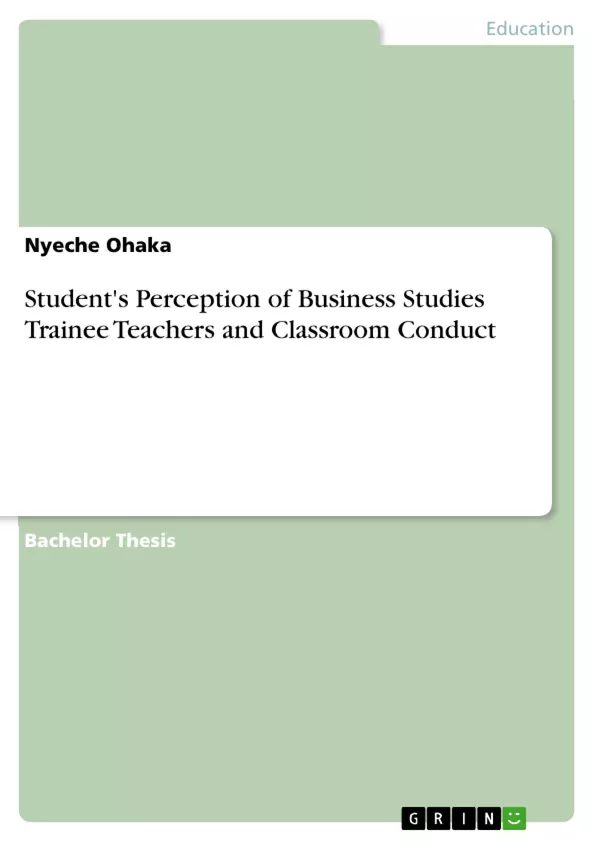The core mandate of this study is to examine students’ perception of Business studies trainee teachers and its influence on their classroom conduct in Port-Harcourt secondary schools. Three research questions were raised to guide the study; while three research hypotheses were also developed and tested at 0.05 level of significance. The study adopts a descriptive research survey method. The total population of the study was 5,725 which consists of 5,522 Junior Secondary School (JSS2) students in Port-Harcourt Secondary Schools and 203 level four (4) hundred students of Business Education department, Rivers State University, Port-Harcourt. A sample size of 509 was drawn using simple random sampling technique. Taro Yamene formular was used to derive the sample size. The instrument for data collection was a self-structured questionnaire developed by the researchers and validated by the research supervisor.
The most pertinent priorities for the business studies trainee teachers in dealing with secondary school students’ misconduct in Port-Harcourt metropolis will be to maintain a secure and safe environment and also protect the classroom environment from threats posed by potentially dangerous troubled students. These priorities will obviously require recognizing the warning signs of trouble and preparedness to respond appropriately and decisively. Other priorities will include maintaining a classroom atmosphere of respect and civility, avoiding being manipulated by students with unreasonable demands, responding appropriately to unfounded allegations, and protecting oneself and one’s institution from frivolous lawsuit. However, understanding how the range of students’ misconduct tends to cluster along certain distinctive, recognizable styles is empowering and helpful to the business studies student teachers.
Inhaltsverzeichnis (Table of Contents)
- CHAPTER 1
- INTRODUCTION
- Background to the Study
- Statement of the Problem
- Purpose of the Study
- Research Questions
- Research Hypotheses
- Significance of the Study
- Scope of the Study
- Definition of Terms
- CHAPTER 2
- REVIEW OF RELATED LITERATURE
- Theoretical Framework of the Study
- Conceptual Framework of the Study
- Secondary school students' perception of the Business Studies trainee Teachers
- Causes of the Secondary School Students' Perception of the Business Studies Student Teachers
- Roles of the business studies student teachers in influencing the secondary school students' perception of them
- Review of Related Empirical Studies
- Summary of Review of Related Literature
- CHAPTER 3
- RESEARCH METHODOLOGY
- The Research Design
- The Population of the Study
- Area of the Study
- Sample Size and Sampling Technique
- Instrument for Data Collection
- Validation of Instrument
- Method of Data Collection
- Data Analysis Technique
- CHAPTER 4
- DATA PRESENTATION AND ANALYSIS
- Data Presentation
- Testing of Hypotheses
- CHAPTER 5
- DISCUSSION OF FINDINGS, SUMMARY, CONCLSIONS AND RECOMMENDATIONS
- Discussion of Findings
- Conclusions
- Recommendations
- Suggestions for Further Studies
Zielsetzung und Themenschwerpunkte (Objectives and Key Themes)
This research project investigates students' perceptions of Business Studies trainee-teachers and classroom conduct in secondary schools in Port-Harcourt. The main objective of this study is to understand and analyze the factors that influence these perceptions.
- The role of trainee-teachers in shaping students' perceptions of Business Studies.
- The impact of classroom conduct on students' learning experiences.
- The influence of students' background and experiences on their perceptions.
- The effectiveness of training programs in preparing trainee-teachers for classroom practice.
- Recommendations for improving the quality of education and student learning.
Zusammenfassung der Kapitel (Chapter Summaries)
Chapter 1 provides a comprehensive introduction to the study, outlining the background, statement of the problem, purpose, research questions, hypotheses, significance, scope, and definition of key terms. Chapter 2 delves into a thorough review of relevant literature, exploring theoretical frameworks, conceptual frameworks, empirical studies, and existing research on students' perceptions of trainee-teachers and classroom conduct. Chapter 3 outlines the research methodology employed in the study, including the research design, population, sample size, data collection methods, and data analysis techniques.
Schlüsselwörter (Keywords)
This research explores key concepts such as students' perceptions, Business Studies trainee-teachers, classroom conduct, secondary schools, empirical research, training programs, and educational quality. It aims to contribute to the understanding of how these factors interact and influence the learning experiences of students in secondary schools.
- Quote paper
- Nyeche Ohaka (Author), 2017, Student's Perception of Business Studies Trainee Teachers and Classroom Conduct, Munich, GRIN Verlag, https://www.grin.com/document/378807



